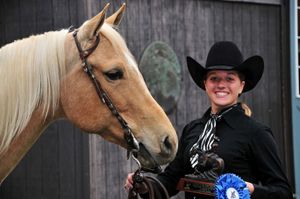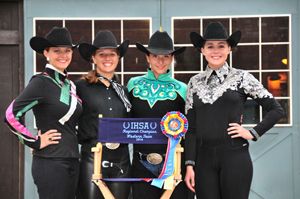Against the odds, the SMWC western equestrian team dominated the 2013-2014 season.
By: Sara Palmer

SMWC senior equine business major, Ali Mahloch
It’s nearly unbelievable – a 21-year-old petite blonde, standing just a hair over 5’5, moving a thick-necked horse that weighs more than 1,000 lbs. backwards across an arena.
For Ali Mahloch it’s not just believable; it’s breathtaking.
“I dance before each show to loosen up the nerves,” said Mahloch, a senior equine business major at Saint Mary-of-the-Woods College. “But ultimately you have to have patience and just let the horse do its job.”
Mahloch has been steadily taking the equestrian world by storm, securing the number one spot in the region in open division, which is the most advanced division in the intercollegiate western equestrian show. She takes off for nationals in May along with two other SMWC riders.
“Ali has a real natural talent,” said Sara Schulz, SMWC’s western team coach and chair of the Department of Equine Studies. “Including Ali, we’ve had the top three open division riders and for one team to have that type of success is unheard of. We dominated the season, with Ali gaining the most points in both open and reigning.”
The SMWC team finished at the top with eight first place wins and two runner-up spots. Just back from an impressive showing at the semi-finals, Mahloch placed first in open team reining and the SMWC team placed sixth overall.
“We’ve competed against some big schools this season,” Schulz said. “We swept the competition by 68 points. Indiana University, Ball State University and Purdue University all have a huge pool of riders to choose from and our little program came in and just dominated. We compete against big ten schools and we’re winning.”
SMWC’s western riders are a small, but mighty team. As cliché as it sounds, these students truly live for the saddle – they eat, breathe and sleep riding. Not only do they have to practice on the horse, but they are also expected to complete a physical fitness regimen four days a week. They are responsible for helping the horses and the stables stay in top shape. Not the least important, they are required to work just as hard in their classes as they do in the arena. Schulz believes that horsemanship skills transfer into many other areas of the students’ lives. From learning how to navigate through a crisis moment to thinking critically and planning ahead, a leader on the horse is also a leader in life.
“I balance it all by not sleeping,” Mahloch joked, “but it is so worth it.”
Ask any one of the riders and they’ll all agree – the long days in the summer heat or winter snow, the late nights churning out papers, the long drives home from a show clear across the state or cleaning up the stables after working a show at home – it’s all worth it.
“I think that riding for the team has honestly made me a better student in college,” said western team rider Erika Stanley, SMWC senior and equine business major. “Sure, there are those days that get tough, but the little positives in each ride and the love I have with the horses pushes me to keep going.”
She finished seventh at the semi-finals in open team rail. Her teammate, Jacqui Peterschmidt, finished eighth in the intermediate team rail.

SMWC western equestrian team members (l to r) Sarah New, Ali Mahloch, Vivian Hansen and Susannah Eckert
“My highest placing has been first and I’ve won three classes this year,” said Peterschmidt, a freshman double majoring in equine training and instruction along with computer information systems. “My favorite show was the Red Oaks Ranch show last semester. I won my class in both the morning and afternoon shows.”
Western shows are an all-day, all-hands-on-deck affair. According to Schulz, there are six divisions – rail, open, advanced, novice, intermediate and walk/trot. Remembering all those names is the easy part. Understanding just how complicated a show really is, that’s the hard part.
As the coach, Schulz picks out who she believes will be her top riders in each division. Each rider gets points depending on how they place, starting with seven for first place, six for second and so on. The team with the most points at the end of the day is awarded the coveted title of high point team.
Believe it or not, it gets even more complicated – the riders don’t bring their own horses to the show. They draw horses they will compete with the day of the event. That’s right; these riders are judged by their skills on a horse they have just met.
“We don’t take our own horses to shows,” Schulz explained. “We have to ride whatever they give us. We don’t get time to warm them up or get to know what the horse feels like or how it will respond. Our riders go in and apply what they’ve learned in practice to the best of their abilities.”
Even with the small number of horses the SMWC riders have for practice, the team makes the most of their time in and out of the saddle. They strategize on how to work with the horses, focusing on communication, not on control.
“Working with an unfamiliar horse is 50% skill, 25% luck and 25% magic,” Peterschmidt said. “Showing a horse is an art. A rider with a lot of experience riding a lot of horses will have an easier time hopping on a strange horse and doing well. It’s a test of true horsemanship.”
This balancing act is just the tip of the iceberg. “We have to do a lot more work than just sitting up there and looking pretty,” Stanley said. “We have to get them to walk, trot and lope in the show pen. Our bodies and voice commands get the horse to do these things, so timing is very important. In reining we do more advanced maneuvers, including spins, sliding stops, flying lead changes and circles.”
Schulz agrees that control is one element of riding, but maintains that communication is the key. “Good riding is about communication and compassion,” she explained. “The old cowboy way was about dominance, and there are times when dominance has to be executed for safety reasons. But you have to read a horse. You have to take the horse into consideration.”
Her tone gets serious. “You have to become the horse.”
Riding, especially as a college sport, seems to be a bit of a mystery to onlookers. It’s not the type of athletic event where students rally to the sidelines, but the SMWC western team believes that cheering and shouting, Pomeroy Pride style, at a show can be just as exciting as on the field or the court.
“The whole team stands by the rail and cheers on our riders,” Peterschmidt said, the memory of a recent win spreading across her face. “There’s a lot of celebration. We won high point team at almost every show this year, and there was always a lot of whooping when the announcer gave the results.”
With bright futures ahead, each one of the riders, regardless of major, plans on staying in the saddle long after graduation. Schulz has built a team spirit that will live on long after graduation.
“There’s truly nothing like it,” she said. “This team, this season, this sport… Watching a show and being a part of the heat, it’s just amazing.”